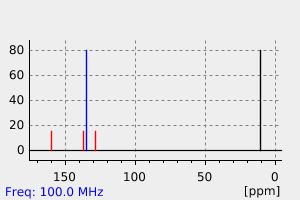4-甲基-2-苯基-1,3-噁唑 | 877-39-4
中文名称
4-甲基-2-苯基-1,3-噁唑
中文别名
4-甲基-2-苯基恶唑
英文名称
4-methyl-2-phenyloxazole
英文别名
2-Phenyl-4-methyl-oxazol;4-Methyl-2-phenyl-oxazol;2-phenyl-4-methyloxazole;4-Methyl-2-phenyl-1,3-oxazole
CAS
877-39-4
化学式
C10H9NO
mdl
MFCD11055268
分子量
159.188
InChiKey
KIDJISUVJMVGAN-UHFFFAOYSA-N
BEILSTEIN
——
EINECS
——
-
物化性质
-
计算性质
-
ADMET
-
安全信息
-
SDS
-
制备方法与用途
-
上下游信息
-
文献信息
-
表征谱图
-
同类化合物
-
相关功能分类
-
相关结构分类
计算性质
-
辛醇/水分配系数(LogP):2.4
-
重原子数:12
-
可旋转键数:1
-
环数:2.0
-
sp3杂化的碳原子比例:0.1
-
拓扑面积:26
-
氢给体数:0
-
氢受体数:2
安全信息
-
海关编码:2934999090
SDS
上下游信息
-
下游产品
中文名称 英文名称 CAS号 化学式 分子量 —— 2-(p-Aminophenyl)-4-methyloxazole 21355-01-1 C10H10N2O 174.202 5-溴-4-甲基-2-苯基-1,3-噁唑 5-bromo-4-methyl-2-phenyloxazole 21354-98-3 C10H8BrNO 238.084 —— 5-bromo-4-(bromomethyl)-2-phenyl-1,3-oxazole 101085-25-0 C10H7Br2NO 316.98
反应信息
-
作为反应物:描述:参考文献:名称:Gompper; Ruehle, Justus Liebigs Annalen der Chemie, 1959, vol. 626, p. 83,91摘要:DOI:
-
作为产物:描述:2-Benzoyl-3-methylisoxazol-5(2H)-one 540.0~600.0 ℃ 、1.33 Pa 条件下, 反应 1.0h, 以95%的产率得到4-甲基-2-苯基-1,3-噁唑参考文献:名称:通过2-酰基苯并恶唑-5-酮的热解或光解合成恶唑摘要:通过在300或254nm处进行光解或通过快速真空热解将N-酰基异恶唑-5-酮转化为相应的2-取代的恶唑。前一种方法适用于在C-4具有吸电子基团的异恶唑酮,而对于所有其他方法均热解。DOI:10.1016/0040-4039(95)02240-6
文献信息
-
Novel Heterocyclic Compounds and Uses Thereof申请人:Huang Zilin公开号:US20130210818A1公开(公告)日:2013-08-15New substituted heterocyclic compounds, compositions containing them, and methods of using them for the inhibition of Raf kinase activity are provided. The new compounds and compositions may be used either alone or in combination with at least one additional agent for the treatment of a Raf kinase mediated disorder, such as cancer.提供了新的替代杂环化合物,含有它们的组合物,以及使用它们抑制Raf激酶活性的方法。这些新化合物和组合物可以单独使用,也可以与至少一种额外的药物联合使用,用于治疗由Raf激酶介导的疾病,如癌症。
-
[EN] DIACYLGLYCEROL ACYLTRANSFERASE 2 INHIBITORS<br/>[FR] INHIBITEURS DE DIACYLGLYCÉROL ACYLTRANSFÉRASE 2申请人:PFIZER公开号:WO2013150416A1公开(公告)日:2013-10-10Derivatives of purine, 3H-imidazo[4,5-b]pyrimidine and 1H- imidazo[4,5-d]pyrazine of Formula I that inhibit the activity of the diacylglycerol acyltransferase 2 (DGAT2) and their uses in the treatment of diseases linked thereto in animals are described herein.
-
Ramoplanin derivatives possessing antibacterial activity申请人:Raju G. Bore公开号:US20060211603A1公开(公告)日:2006-09-21Novel ramoplanin derivatives are disclosed. These ramoplanin derivatives exhibit antibacterial activity. As the compounds of the subject invention exhibit potent activities against gram positive bacteria, they are useful antimicrobial agents. Methods of synthesis and of use of the compounds are also disclosed.
-
Synthese de pyrroles et d'oxazoles par pyrolyse de N-(hydroxy-2′ ethyl) amino-3 propenoate作者:Catherine Pale-Grosdemange、Josselin ChucheDOI:10.1016/s0040-4020(01)81018-8日期:1989.1pyrolysis of various N-(2′-hydroxyethyl)-3-amino propenoates 1–6 and N-(2′-hydroxy-2′-phenyl ethyl)-3-amino propenoate 7–9 at 390°–420°C leads respectively to formylpyrroles 11–16 and benzoylpyrroles 17–19 and, in some cases, to substituted oxazoles 36–39. The results are best explained by the intermediate formation of dicarbonyl derivative followed either by an intramolecular thermal crotonisation
-
Chemistry of 5-oxodihydroisoxazoles. Part 18.1 Synthesis of oxazoles by the photolysis and pyrolysis of 2-acyl-5-oxo-2,5-dihydroisoxazoles作者:Rolf H. Prager、Jason A. Smith、Ben Weber、Craig M. WilliamsDOI:10.1039/a700134g日期:——N-Acylisoxazol-5-ones lose carbon dioxide under photochemical and thermal conditions affording iminocarbenes which undergo intramolecular cyclisation through the oxygen of the acyl group to give oxazoles. Under photochemical conditions those acylisoxazolones with electron withdrawing groups at C-4 usually give high yields of oxazoles, while those with electron donating groups at C-4 give only poor yields: the reverse is observed under thermal conditions.
表征谱图
-
氢谱1HNMR
-
质谱MS
-
碳谱13CNMR
-
红外IR
-
拉曼Raman
-
峰位数据
-
峰位匹配
-
表征信息
同类化合物
(SP-4-1)-二氯双(1-苯基-1H-咪唑-κN3)-钯
(5aS,6R,9S,9aR)-5a,6,7,8,9,9a-六氢-6,11,11-三甲基-2-(2,3,4,5,6-五氟苯基)-6,9-甲基-4H-[1,2,4]三唑[3,4-c][1,4]苯并恶嗪四氟硼酸酯
(5-氨基-1,3,4-噻二唑-2-基)甲醇
齐墩果-2,12-二烯[2,3-d]异恶唑-28-酸
黄曲霉毒素H1
高效液相卡套柱
非昔硝唑
非布索坦杂质Z19
非布索坦杂质T
非布索坦杂质K
非布索坦杂质E
非布索坦杂质D
非布索坦杂质67
非布索坦杂质65
非布索坦杂质64
非布索坦杂质61
非布索坦代谢物67M-4
非布索坦代谢物67M-2
非布索坦代谢物 67M-1
非布索坦-D9
非布索坦
非唑拉明
雷非那酮-d7
雷西那德杂质2
雷西纳德杂质L
雷西纳德杂质H
雷西纳德杂质B
雷西纳德
雷西奈德杂质
阿西司特
阿莫奈韦
阿考替胺杂质9
阿米苯唑
阿米特罗13C2,15N2
阿瑞匹坦杂质
阿格列扎
阿扎司特
阿尔吡登
阿塔鲁伦中间体
阿培利司N-1
阿哌沙班杂质26
阿哌沙班杂质15
阿可替尼
阿作莫兰
阿佐塞米
镁(2+)(Z)-4'-羟基-3'-甲氧基肉桂酸酯
锌1,2-二甲基咪唑二氯化物
锌(II)(苯甲醇)(四苯基卟啉)
锌(II)(正丁醇)(四苯基卟啉)
锌(II)(异丁醇)(四苯基卟啉)







